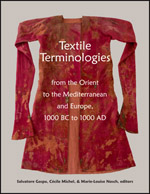Center, Textile Research

Textile Terminologies from the Orient to the Mediterranean and Europe, 1000 BC to 1000 AD
Date of this Version
2017
Document Type
Article
Citation
In Textile Terminologies from the Orient to the Mediterranean and Europe, 1000 BC to 1000 AD, ed. Salvatore Gaspa, Cécile Michel, & Marie-Louise Nosch (Lincoln, NE: Zea Books, 2017), pp. 235-249
doi:10.13014/K2TM789Q
Abstract
The colour purple evokes an inestimable, priceless luxury in our understanding. It almost belongs in a legendary world along with other exquisite goods. Purple is seen as example par excellence for a symbol of social status, a token of prestige. A significant study on the importance of purple has brought to light the persistent desire for this colour throughout the Greek and Roman world.2 Literary sources from Roman times provide us quite comprehensive information on the colour and its sources. The most often quoted author is doubtlessly Caius Plinius Secundus, known as Pliny the Elder, who compiled specialist knowledge in 37 books on various topics. In the chapter on sea animals of his Naturalis Historia Pliny covers shellfish, amongst them the purple snails (Plin. NH 9.124–141). At this point Pliny gives a description of the purple dyestuff obtained from the animal and describes the dyeing process (Plin. NH 9.133–135). His excursus is the most detailed ancient description of the dyeing method with mollusc-purple upon which modern experiments in dyeing are based.3 However, the actual reason, why Pliny describes purple dyeing, is not that he is interested in dyeing fabrics in the first place. He describes maritime creatures, in particular the sea snails, and as such he pays some tribute to its characteristic feature: the colourfast dyestuff purple. The Roman author Vitruvius and his work De architectura provides further information. Unlike Pliny, Vitruvius focuses on colours used as pigments for painting (decorae picturae, as in Vitr. De arch. 7.13–14). Already in his description diverse terms for ‘purple’ are used and it shows quite obviously, that different kinds of purple were produced, even from various species of molluscs.
1. Incipiam nunc de ostro dicere, quod et carissimam et excellentissimam habet praeter hos colores aspectus suavitatem. Id autem excipitur e conchylio marino, e quo purpura efficitur, cuius non minores sunt quam ceterarum naturae considerantibus admirationes, quod habet non in omnibus locis, quibus nascitur, unius generis colorem, sed solis cursu naturaliter temperatur. 2. Itaque quod lexitur Ponto et Gallia, quod hae regiones sunt proximae ad septentrionem, est atrum; progredientibus inter septentrionem et occidentem invenitur lividum; quod autem legitur ad aequinoctialem orientem et occidentem, invenitur violacio colore; quod vero meridianis regionibus excipitur, rubra procreatur potestate, et ideo hoc Rhodo etiam insula creatur ceterisque eiusmodi regionibus, quae proximae sunt solis cursui. 3. Ea chonchylia, cum sunt lecta, ferramentis circa scinduntur, e quibus plagis purpurea sanies, uti lacrima profluens, excussa in mortariis terendo comparatur. Et quod ex concharum marinarum testis eximitur, ideo ostrum est vocitatum. Id autem propter salsuginem cito fit siticulosum, nisi mel habeat circa fusum.
Included in
Ancient History, Greek and Roman through Late Antiquity Commons, Art and Materials Conservation Commons, Classical Archaeology and Art History Commons, Classical Literature and Philology Commons, Fiber, Textile, and Weaving Arts Commons, Indo-European Linguistics and Philology Commons, Jewish Studies Commons, Museum Studies Commons, Near Eastern Languages and Societies Commons, Other History of Art, Architecture, and Archaeology Commons


Comments
Copyright © 2017 Salvatore Gaspa, Cécile Michel, & Marie-Louise Nosch. Photographs copyright as noted.